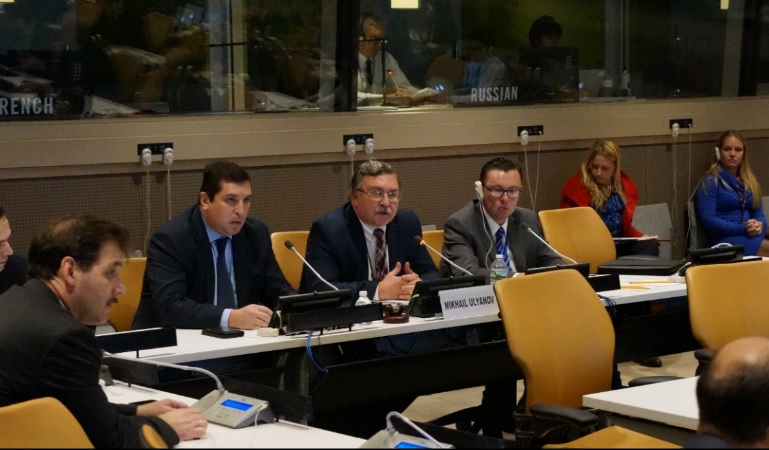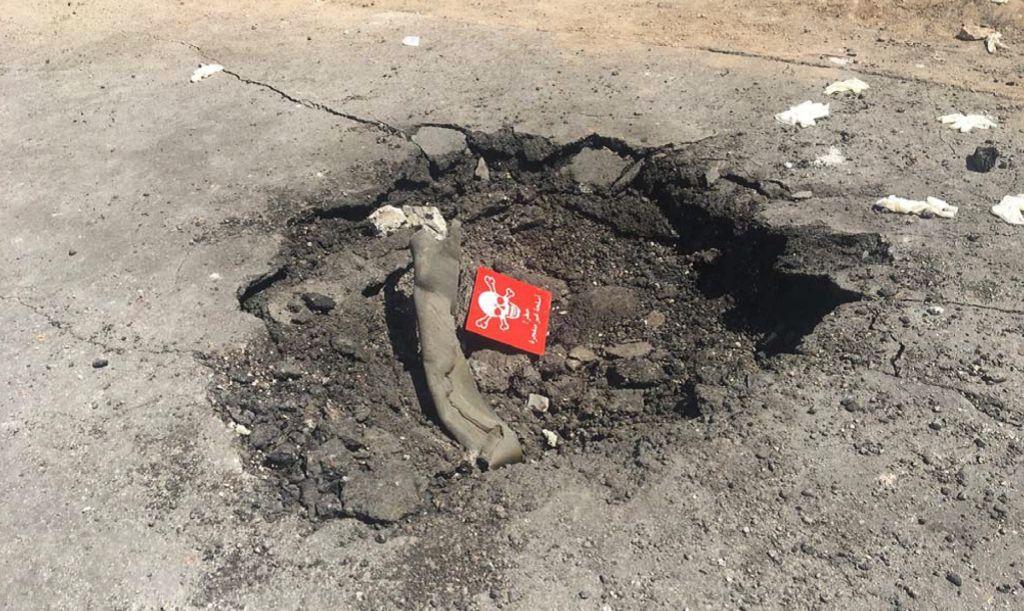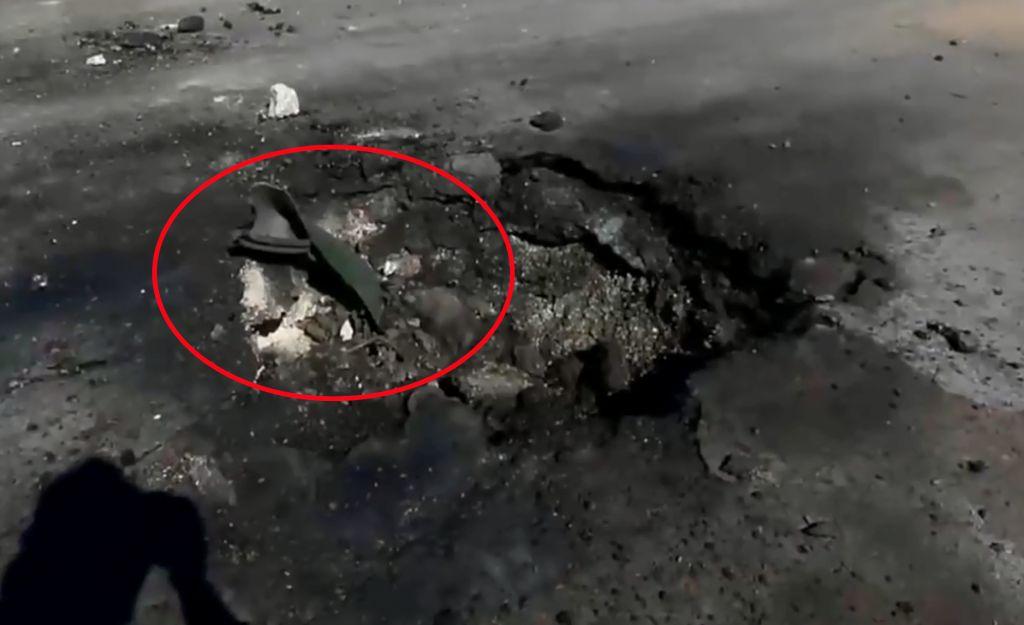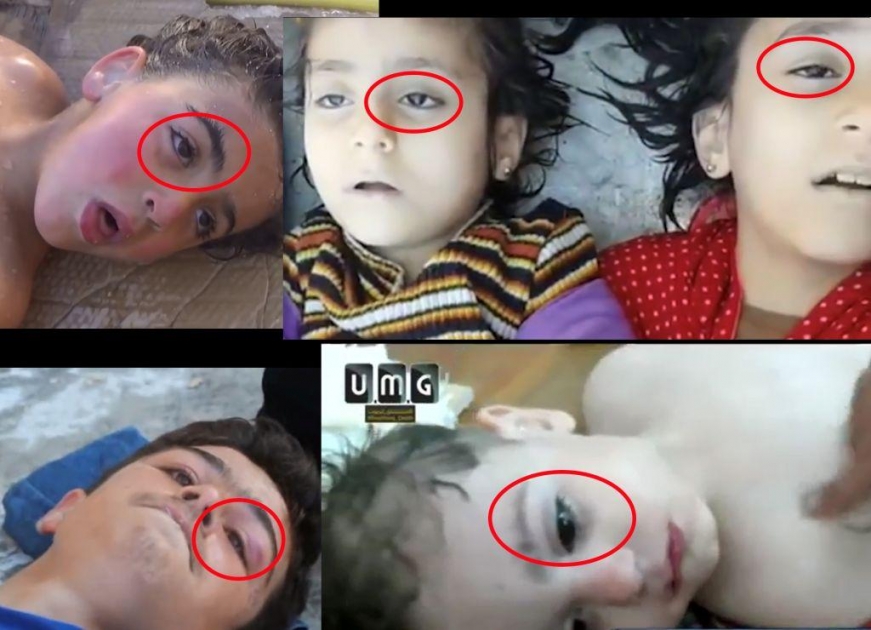Briefing «SYRIAN CHEMICAL DOSSIER: THE RUSSIAN VIEW» by Ambassador Mikhail Ulyanov Head of the Russian delegation in UNGA First Committee, Director of the Department for Non-Proliferation and Arms Control of the MFA of Russia on the margins of the 72nd session of the UN General Assembly
Dear colleagues,
We have organized this briefing following the proposals of a number of member states of the UN Security Council who believe that the Russian point of view on Syrian chemical file is of certain interest to other delegations including those who maintain different views. We have gladly responded to this recommendation since a lot of speculations are circulating around the chemical files in general and Russian position in particular while this briefing allows all interested partners to obtain first-hand information from us.
Let us say in the beginning that the repeated chemical incidents have become a new and extremely dangerous phenomenon of the recent years. For the time being they happen mostly in Syria and to a lesser extent in Iraq. There is a real risk however that the use of chemical warfare by terrorist groups would spill over beyond these countries and even the entire region of the Middle East.
Let me recall that the first or one of the first chemical incidents took place in Syrian Khan al Assal town in March 2013. Then the militants of one of the opposition factions used sarin against Syrian military and civilians. Later such incidents reoccurred many times.
Naturally, this required a response from the OPCW and the UN Security Council.
In May 2014 the OPCW Technical Secretariat and Damascus reached an agreement by letter exchange on establishing a Fact Finding Mission in Syria (FFM). This understanding clearly defined the tasks, terms of reference and working methods of this new body.
Since the FFM mandate does not provide for determining the perpetrators of chemical crimes, a little later in summer 2015 the UN Security Council established the UN-OPCW Joint Investigative Mechanism (JIM), especially to fill in this gap. Russia most actively participated in agreeing upon its mandate and supported the establishment of this Mechanism.
Such a decision was dictated by our most resolute condemnation of chemical warfare crimes no matter whoever or wherever committed them. We deem it necessary to insist on tracking down and prosecuting the perpetrators in each particular case. We expected that the establishment of FFM and JIM would really help achieve this goal. What was required? First, to faithfully fulfill the mandate of these two bodies in full scope rather than selectively. Second, they had to use the entire set of means and methods of investigation. As a benchmark they could rely on the high standards provided for in the Chemical Weapons Convention (CWC). This implies first of all the collection of evidence and samples and interviewing witnesses directly on the scene of crime. Third, absolute impartiality and understanding of highest responsibility for the results of investigation are required.
Unfortunately, as it became clear later there are serious problems with implementing all these prerequisites to establish the truth. Let me emphasize, however, before I give specific examples that confirm this claim that we naturally realize that FFM and JIM are working in extremely difficult conditions of active combat operations in Syria. Moreover, it is complicated by extreme international politicization of Syrian chemical files. As a result the OPCW where for many years all decisions were taken by consensus faced a deep division. Due to the politicization the principles of benefit of the doubt and presumption of innocence practically stopped to be applied to Syria. As soon as another chemical incident happens in Syria we hear a powerful international clamor accusing Damascus of committing the crime even before the investigation has started. That was the case in August-September 2013, after the events in the Eastern Ghouta. The same repeated last April after the events in Khan Shaykhun. In should be noted that in the latter case Damascus was not only immediately «assigned» to be a guilty party but «punished» by a massive missile attack on Shayrat air base where chemical agents used in a Khan Shaykhun had been allegedly stored. All this looks like a “bad déjà vu” – a repetition of a memorable history with “weapons of mass destruction of Saddam Hussein”. Apparently, not all states can draw lessons from this shameful history and prefer to follow the well trodden road even not trying to show the wits and come up with something new.
Naturally the abnormal political atmosphere around the Syrian chemical files objectively prevails over FFM and JIM and actually becomes the means of pressure against them. In order to question or refute the verdict already passed by the influential countries, they even in presence of heavy evidence need to have true independence and great professional courage.
Nevertheless, these difficulties cannot serve as justification for abandoning the three basic prerequisites for objective and professional investigation that I mentioned earlier. Let us take as an example the issue of faithful compliance with the mandate. In accordance with the exchange letters between OPCW and Damascus, decisions of OPCW Executive Council of 4 February and 23 November 2015 and paragraph 5 of UN Security Council resolution 2209 the task of FFM is to study all available information relating to allegations of the use of chemical weapons in Syria. At the same time the FFM itself now claims that its task is exclusively to establish whether chemical weapons were used or not. This narrow interpretation that the Mission had chosen against its own mandate would exempt it from the need to collect and study all available information and establish all pertinent facts. As a result the FFM reports cannot be of great help to further JIM activities to establish the perpetrators.
Let me give you another example. Despite high standards of investigation stipulated inter alia in Chemical Weapons Convention the FFM and JIM experts never go to the site of chemical incident and prefer to conduct investigation remotely, by sitting in the Hague or New York offices or at best in one of Syria’s neighboring countries. Moreover this practice is backed up by a conceptual basis in the form of a growing number of assertions that the modern technical means make it possible to conduct a full scope investigation quite afar from the site of event. And this is stated quite seriously. Colleagues, can you imagine a criminal court to accept a case which the police decided to investigate only remotely without burdening themselves with going to the scene of crime.
As to objectivity and impartiality in the operation of international institutions they are ensured, inter alia, by recruiting their staff from various countries and regions. Paragraph 12 of FFM mandate clearly says that the composition of the mission should be balanced. The UN Charter (Article 101), the CWC and its annexes related to verification clearly state that the international personnel should be recruited on as wide geographical basis as possible. What is the actual situation in the FFM in this respect? The composition of the mission is kept secret but we managed to find out that as of last April it was totally composed of the representatives of the Western group of states. Does it mean that they were unable to find good experts in other regions? Moreover for some reason both segments of FFM were headed by UK citizens. We can admit these persons are brilliant professionals but total domination of British representatives in the FFM leadership cannot but raise questions, even more so that the UK position as regards the Syrian conflict can hardly be called impartial. To do justice it should be noted that after Russia publicly raised this issue in OPCW, certain adjustments were made to the mission’s composition, but not to the extent required.
Let me give you another example. It would seem that the conclusions of the international entities that conduct investigation should be flawless, based on evidence and irrefutable. But in reality quite often it is not the case. For example the forth JIM report issued in fall last year claimed that Damascus was guilty in three cases of chemical attacks. One of these three episodes had been linked with absolutely fantastic scenario. Allegedly, in 2015, in the area of Sarmin town the Syrian government air force helicopter flying at a high altitude at night dropped a barrel with chlorine, which fell exactly into the ventilation shaft of an apartment building, almost of the same diameter. The report recognizes that it “sounds improbable” and nevertheless the responsibility has been put on the government of Syria in spite of any common sense and the laws of ballistics. It is absolutely impossible to take seriously the conclusion made by JIM. It looks either as a bad joke or even a mockery of the conduct of professional investigation. Nevertheless the conclusions of JIM have been actively circulated including in a draft resolution on the CWC during the current UN GA session.
Serious shortcomings in the activities of FFM quite obviously transpired during the investigation of the resounding chemical incident in Khan Shaykhun. Putting aside secondary aspects one can single out four areas where the mission fell short on its task.
First from its inception the mission has shown stubborn unwillingness to visit the site of incident. As an excuse it referred to the absence of appropriate security conditions. As it became clear last week the UN Secretariat Department of security managed to obtain guarantees of safe access to the site of event from the field commanders who control the area of Khan Shaykhun. However the FFM didn’t show its readiness to use this opportunity having preferred to conduct investigation on the territory of a country neighboring Syria. We consider this fact to be outrageous and showing that instead of serious investigation the FFM has simply engaged in its imitation.
Second, by declining to visit Khan Shaykhun the mission did not follow the necessary sequence of actions to ensure integrity of evidence, i.e. it violated the basic principle of investigation known as the “chain of custody”. The biomedical samples and environmental samples were obtained by FFM not on the site of the incident as it should have been done but on the territory of another country from the opposition factions hostile to Damascus. Thus there’s no certainty that these samples were actually collected in Khan Shaykhun and not in another site on the territory of Syria or even some other country. The same relates to dead birds that were allegedly killed by sarin and the bodies of dead people and victim survivors. There is no certainty either that these people stayed in Khan Shaykhun in the morning of 4 April. We were able to accept the statement that sarin was actually used in Khan Shaykhun only after the Syrian authorities with the risk for the life of their supporters managed to collect samples on the site of event and conduct their independent analysis that confirmed the presence of sarin traces.
Third, the report does not contain any information on the way how sarin was used. It has only mentioned that the FFM was unable to come to a firm conclusion on this issue despite the fact that this is a key aspect for establishing the truth.
Forth, the fact that FFM categorically refused to visit Shayrat air base where sarin used in Khan Shaykhun had been allegedly stored became a fundamental shortcoming of this investigation. They failed to do so despite persistent invitations by Syrian authorities who pledged to ensure free and safe access of international personnel to this facility. This refusal directly contradicts paragraph 12 of FFM mandate and has no explanation. Indeed if there is a suspicion that sarin is stored in the air base the FFM instead of avoiding it had to insist on visiting this facility to be able to expose the violation of CWC by Damascus and prevent the new cases of sarin attacks. Actually the FFM has demonstrated its unwillingness to establish all facts relating to the case against its own mandate.
Thus the FFM report in spite of all expectations and due to its poor quality failed to become a useful support for JIM work that took charge on this case. The Mechanism will have not only to check again the data provided by FFM but collect independently the required additional information as provided for in its mandate, which was left out by FFM. The report of the Mechanism on the outcome of Shaykhun incident investigation is expected by 26 October. We are going to review it in most carefully to determine the quality of its work moreover since in November the UNSC will have to determine whether it is appropriate to further extend the JIM mandate. At this stage we are worried by the fact that the Mechanism, as the FFM earlier, hasn’t shown for a long time its slightest interest in visiting the Shayrat air base, albeit such a visit is absolutely necessary to verify the version of the use of sarin air bomb in Khan Shaykhun. Finally the JIM came to a decision to visit the air base no matter what was the purpose. The Mechanism experts were not assigned the task to verify the presence or absence of sarin at the air base. The JIM personnel did not take samples for further analysis despite the fact that a reliable investigation is simply impossible without sampling. A scandalous situation arises. A number of capitals contend that sarin has been stockpiled at the airbase. The OPCW experts, as far as we know, are ready to take samples should they receive a relevant order from the JIM leadership. Relevant equipment belonging to OPCW has been stored in Damascus. The Syrian authorities have guaranteed a free and safe access to the airbase. More than one month is remaining to the expiration of the current JIM mandate and there is still time to collect and analyze the samples. Nevertheless for reasons that we cannot understand the JIM leadership is refusing to give appropriate instructions. I fear that this shows not only the inability but unwillingness to conduct truly high quality investigation. We cannot assess the current situation in any other way.
A question comes into mind – what has actually happened in Khan Shaykhun? Unlike some of our partners we do not intend to categorically impose our point of view. We believe that JIM must work out all versions including air strike. We expect at the same time that the version of staged incident would also be carefully studied since frankly speaking we tend more and more to opt for that version. It is supported in particular by the following circumstances. The analysis of the photographs of explosion crater leads us to doubt that it was a result of an air bomb strike. According to Russian military experts if the air bomb were used the crater would be five to six meters in diameter and up to two meters deep. The photo and video footage prove that the shape of the crater in Khan Shaykhun is much smaller – 1 to 1,5 meters in diameter and only half a meter in depth. Moreover the size and geometrical shape of the crater and the direction of the rims of asphalt pavement on its perimeter not outwards but inwards the hole in the ground formed after the explosion prove that the explosion of sarin container was set off directly on the ground. Most likely the improvised explosive device was placed on its surface and the container had less than 1,2 kg of chemical agent. The version of a bomb used in Khan Shaykhun so popular among some of our western partners is refuted by the fact that no fragments of the bomb were detected on numerous photo and video materials from the site of event. However a crushed metallic tube is clearly seen in the explosion hole, which has nothing to do with the air bomb. It is obvious that this was a key material evidence that could clarify the method of sarin use and help track down the perpetrators. Nevertheless the FFM, which willingly accepted the bodies of dead birds and the skin of a goat from the hands of the opposition didn’t even care to demand the abovementioned tube to be presented for studying. It remains only to guess where this tube is now. Besides, the armed factions that control the Khan Shaykhun area hastily covered this cavity with asphalt apparently to hide the traces of the crime.
I would like to recommend you to read the analytical articles of independent American researchers Theodore Postol and Scott Ritter who on the basis of technical analysis came to interesting conclusions that mainly coincide with Russian assessment. The copies of the articles are available in this room.
You can see that children who allegedly were sarin victims had the pupils extended to the maximum whilst in the case of sarin attack they should shrink to the size of a dot. By all indications the children shown in the photographs actually were exposed to the influence of psychotropic substances. Those who posted these photographs in the Internet and according to the media provoked by this posting the decision on missile attack on Shayrat air base clearly had poor understanding of the effects of sarin. A question comes to mind if they are the same actors who had poisoned the children with narcotics to heighten the emotions around this chemical incident. Anyhow this provocation turned out to be quite productive.
Now let me show to you two video footages. You can see how immediately after the incident a rescue team wearing advanced protective suits rushes into the scene while other people in civilian clothes stand around. They secure the site of event with warning signs, take samples and collect the bodies of dead birds. When asked by the cameraman they categorically stated that sarin had been used there while it took several weeks for OPCW to establish this fact. While it is happening we observe quite peaceful life going around: the cars and pedestrians are moving and cyclists are passing by. A clear impression is formed that the rescue team arrived at the site of event well before it happened. In any case we cannot but be surprised by the prompt arrival of the rescue team in full gear to the site of the incident. This seems quite unusual for a town with population of 40 000.
In the second footage we see the representatives of “White Helmets” organization who take samples directly from the crater allegedly contaminated by high concentration sarin. However they have no protective gear except cotton gloves and respirators that cannot give protection against sarin. Apparently those who made this footage were unaware and made a blunder. What your see on the screen gives us grounds to assume that initially an explosion was set off on the ground which formed a crater. Then manipulations were conducted allegedly to take samples from this crater and then later sarin was dispersed on the site. Naturally this is just a version which should be elaborated on by the JIM experts but it certainly deserves attention. We will see whether the Mechanism experts would work on it and cover the results of the study in their report.
As food for thought I would like to make one more point. When we discuss such a sensitive topic it is sometimes useful to “switch on” our common sense and ask ourselves a simple question - who is benefiting from chemical attacks. The answer is obvious – anybody but Damascus which would immediately become a loosing party and be exposed to international obstruction and even to bombardment. The Syrian government doesn’t get slightest advantage from these incidents since they typically happen far away from the front line and in no way affect the balance of forces. The use of chlorine as a weapon when there are high yield conventional air bombs – is nonsense. Chemical weapons of sarin type by definition are intended for massive use but in no way as unitary explosive devices as it was the case in Khan Shaykhun. Speaking about the advantages from the use of chemical substances there is no doubt that they would be gained by radical opposition which not without reason hopes to provoke hostilities against Syria from outside or at least increase international pressure on Damascus. It would be useful for all of us including FFM and JIM personnel to take account of this fact.
Let me emphasize one more important point. Last year Russia supported the decision to extend the JIM mandate. We accepted it because the mechanism under UN Security Council resolution 2319 was given a wider competence in terms of its geography and counter-terror activities. The Mechanism was instructed to cooperate with the countries of the region in order to track down the individuals and groups involved in chemical incidents in Syria. It was proposed to pay more attention to the issue of non-state actors’ access to chemical weapons and their components. So far we have not received yet any information on JIM’s activities on these issues. Let’s see how these topics will be reflected in the forthcoming report.
In conclusion let me raise another issue of principle. Sometimes we are being admonished that Russia by raising the question on failures in the activity of FFM and JIM would undermine the authority of these institutions. We categorically reject such statements. The damage to reputation in fact is done by the investigators who forget about or deviate from the established rules. We never tried to impose on them anything more than what has been provided for in their mandates. We never tried to engage in micromanagement. But if we see serious problems with strict fulfillment of the mandate we feel that we are not only entitled but obliged to focus our attention on this fact in the interest of highly professional and impartial investigation and prosecution of perpetrators of crimes related to the use of chemical weapons.
Thank you for your attention.



